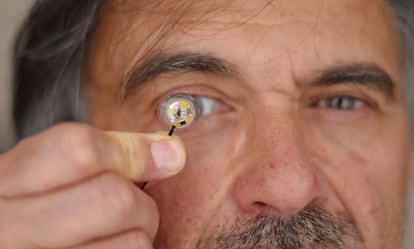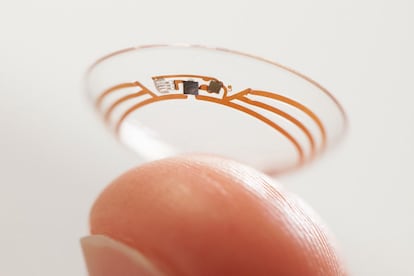Sci-fi no more: Introducing the contact lenses of the future
In addition to correcting sight, researchers are working on features such as augmented reality, night vision and the ability to zoom in and out, as well as the diagnosis and treatment of pathologies

More and more companies and scientists are working to equip contact lenses with applications that not long ago still seemed like science fiction, such as the ability to record videos or diagnose and even treat diseases. Mojo Vision, an American startup, is one company that has been improving its prototypes since 2015. It is currently developing an ambitious project involving augmented reality lenses that, in addition to correcting your vision, will let you consult all kinds of information, from the trails on a ski slope to your pace when you run, all through microLED displays the size of a grain of sand.
“In the short term, it sounds like a futuristic idea, but 20 years ago we couldn’t even imagine many of the technological advances that we have today,” says Ana Belén Cisneros del Río, deputy dean of the College of Opticians-Optometrists in the Spanish region of Castilla y León, of the Mojo Vision project. However, Daniel Elies, a specialist in cornea, cataract and refractive surgery and medical director of the Institute of Ocular Microsurgery (IMO) Miranza Group in Madrid, does not believe that this type of contact lens will become part of everyday life anytime soon, “especially due to cost issues.”
One of the companies interested in manufacturing augmented reality contacts is Magic Leap. Sony, for its part, applied a few years ago for a patent for lenses that can record videos, and Samsung did the same for lenses equipped with a camera and a display that projects images directly into the user’s eye. Some researchers are trying to create robotic lenses that can zoom in and out with the blink of an eye, and yet others are working on night vision contact lenses, which could be useful in military applications.
According to research published in the journal Science Advances, some manufacturers use opaque and brittle components in the smart contact lenses, which, the authors point out, could block the user’s vision and damage the eye. For this type of contact lens to come onto the market, in addition to overcoming multiple technical challenges, it is essential that they do not pose any risk to eye health. “It is still a foreign body that we put into the eye,” says Cisneros, who insists on the importance of researching the development of materials that are biocompatible with the surface of the cornea.
Health monitoring
If there is one field where both scientists and tech giants are trying to harness the potential of contact lenses, it is health. A review published in the journal Advanced Materials Technologies explains that contact lens sensors can be used to monitor many diseases and conditions: “The presence of biomarkers in the tear fluid will lead to diagnostic contact lenses that will help detect and treat systemic and ocular diseases, such as diabetes, cancer and dry eye syndrome,” says Cisneros.

The expert predicts that future lenses will be able to monitor eye pressure, look for glaucoma (a disease that damages the optic nerve) and even produce images of the retinal vasculature for the early detection of hypertension, stroke and diabetes. For patients with the latter, lenses capable of measuring blood glucose levels would be helpful; something that companies like Google and Microsoft have been working on for years. Other scientists have tried to go further and create a version that changes color to alert about changes in the glucose levels.
One limitation of these lenses is that they can generally only detect a single biomarker in the eye, such as glucose or lactic acid, according to the review published in the journal Advanced Intelligent Systems. The authors believe that developing lenses capable of detecting multiple chemical components in real time “will make contact lenses more powerful as biomedical tools.”
Drug delivery using contact lenses
These lenses could also be useful for the treatment of some eye pathologies. In fact, several investigations highlight their potential as portable medical devices to analyze the eye’s response to some drugs and evaluate surgical procedures. “Drug-delivering contact lenses could offer more precise dosage than traditional eye drops, increasing the time that a drug remains on the ocular surface and reducing side effects,” adds Cisneros.
It’s still too early to know what innovations will be incorporated into contact lenses in the coming decades, but the possibilities are endless. Elies does not rule out a distant future in which they are equipped with sensors or a camera capable of recording the eye’s inner data and can make diagnoses or send warnings.
Sign up for our weekly newsletter to get more English-language news coverage from EL PAÍS USA Edition
Tu suscripción se está usando en otro dispositivo
¿Quieres añadir otro usuario a tu suscripción?
Si continúas leyendo en este dispositivo, no se podrá leer en el otro.
FlechaTu suscripción se está usando en otro dispositivo y solo puedes acceder a EL PAÍS desde un dispositivo a la vez.
Si quieres compartir tu cuenta, cambia tu suscripción a la modalidad Premium, así podrás añadir otro usuario. Cada uno accederá con su propia cuenta de email, lo que os permitirá personalizar vuestra experiencia en EL PAÍS.
¿Tienes una suscripción de empresa? Accede aquí para contratar más cuentas.
En el caso de no saber quién está usando tu cuenta, te recomendamos cambiar tu contraseña aquí.
Si decides continuar compartiendo tu cuenta, este mensaje se mostrará en tu dispositivo y en el de la otra persona que está usando tu cuenta de forma indefinida, afectando a tu experiencia de lectura. Puedes consultar aquí los términos y condiciones de la suscripción digital.
More information
Últimas noticias
Most viewed
- Reinhard Genzel, Nobel laureate in physics: ‘One-minute videos will never give you the truth’
- Oona Chaplin: ‘I told James Cameron that I was living in a treehouse and starting a permaculture project with a friend’
- Pablo Escobar’s hippos: A serious environmental problem, 40 years on
- Why we lost the habit of sleeping in two segments and how that changed our sense of time
- Chevy Chase, the beloved comedian who was a monster off camera: ‘Not everyone hated him, just the people who’ve worked with him’











































